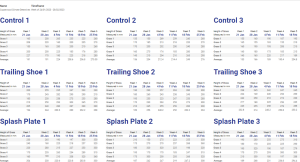Climate Detectives Projects 2022-2023
Project title: Splash Plate V Trailing Shoe
Team: Salesians
Pallaskenry Pallaskenry Ireland 9 Student’s age: 16-17 years old
Does the ‘Trailing Shoe’ method of slurry application reduce the requirement for artificial fertilisers on crops/grassland compared to the ‘Splash Plate’ method?

Many things are to be considered when farming, especially how to be most efficient while being sustainable. After learning about different methods of fertilising crops we came across different methods of applying slurry. From there two primary goals were established; 1) Conduct the experiment, collect, format, and analyse the data, 2) Create a way to spread our findings to the public and create awareness. The fields were laid by tractor pulling a slurry tank and both methods of slurry application were done. 100g of grass were collected from each method, put into beakers, weighed out and of slurry application, placed into beakers and put in an oven at 150C in 10 minute increments (3 hours) until the dry matter mass didn’t change. Over a six week studying analyzing the rate of grass growth based on the method of slurry application our results concluded the following. While there wasn’t a significant difference in the gases released trailing shoe provided a higher Dry matter content implying it to have a higher nutrient level being good for the environment and for the cows leading to richer meat.

Over a six week studying analyzing the rate of grass growth based on the method of slurry application our results concluded the following.
Slurry applied via the trailing shoe method was more effective in promoting grass growth in comparison to the splash plate method. Slurry applied to grass via splash plate led to a higher dry matter % (weight of grass when water is removed) while trailing shoe had higher levels of crude protein and a higher DMD (dry matter digestibility).
– Dry matter is the proportion of total components (fibres, proteins, ash, water-soluble carbohydrates, lipids, etc) remaining after water has been removed.
– DMD is the ratio of dry mass that is absorbed and used by the body.
– D value is the measure of digestibility of the proportion of the forage that can be digested by livestock and is made up of crude protein, carbohydrates and lipids.
– -Water-soluble carbohydrates are the soluble sugars that are quickly released from grass within the rumen. These sugars provide a readily available source of energy for the rumen microbes that are responsible for digesting forage. Meaning more energy is provided for the cows.
From these results (in the chart below) we can conclude, a higher dry matter % indicates a higher level of nutrients in the grass.
Trailing Shoe had a higher dry matter content than the splash plate application which proves that the uptake of nutrients into the grass from trailing shoe application was better meaning less ammonia was lost .
Fertilizers high in nitrogen can affect the crude protein levels in grass which could explain why the control contains higher levels of crude protein.

Our secondary goal was to figure out how to spread this information for the public and most importantly farmers. We created flyers containing information about what our project is about and the benefits of using the trailing shoe method of applying slurry rather than the splash plate method.
Projects are created by the teams and they take the full responsibility of the shared data.
← All projects





